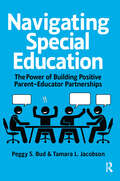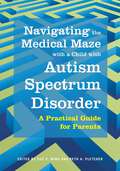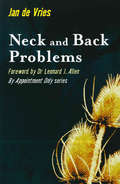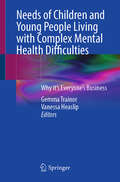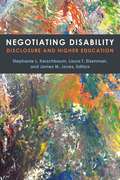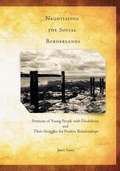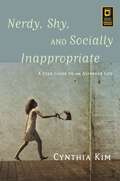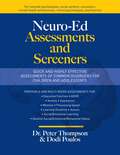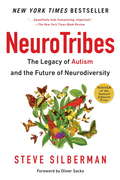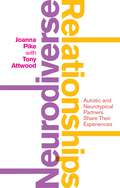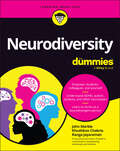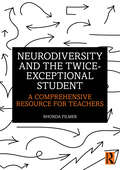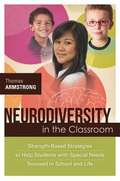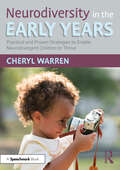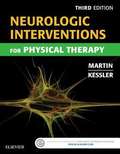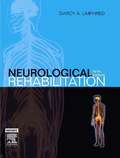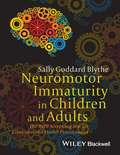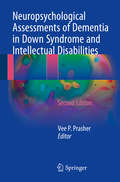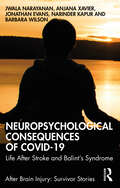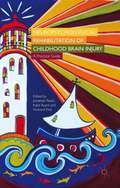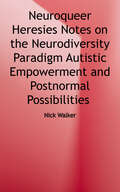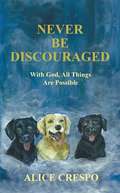- Table View
- List View
Navigating Special Education: The Power of Building Positive Parent-Educator Partnerships
by Peggy Bud Tamara JacobsonThis timely and innovative roadmap for parents, educators, and administrators highlights the importance of effective communication methodology, appropriate correspondence, and data collection recommendations. Effective communication is often missing from the IEP team’s conversation. Navigating Special Education provides a foundation for building proactive, positive partnerships that will lead to 21st century best practices for children.The 5-C Model of Communication—Conversation, Collaboration, Cooperation, Compromise, and Consensus—presented in Navigating Special Education helps to forge trusted alliances between school districts and families.Navigating Special Education draws upon the authors’ 60-plus years of combined experience by using: Anecdotal, evidence-based, real-life scenarios Templates for letter writing and extensive data collection A user-friendly appendix and glossary As stakeholders, wouldn’t you like to have successful meetings where everyone’s voice is heard, respected, and understood? After reading Navigating Special Education, families, educational professionals, college students, and special education organizations will be able to implement effective models of communication and build positive partnerships.
Navigating the Medical Maze with a Child with Autism Spectrum Disorder: A Practical Guide for Parents
by Lisa Ford Julie O'Brien Jennifer Bain Mark D. Robinson Harumi Jyonouchi Jeffrey Kornitzer Caroline Hayes-Rosen Devorah Segal Sue Ming Beth Pletcher Tishi Shah Thomas Ballesteros Barbie Zimmerman-Bier Gary Mcabee Susan Brill Evan Spivack Susan Connors Iona MonterioThis comprehensive guide enables parents of children with an autism spectrum disorder (ASD) to play an active and effective role in their child's medical care from diagnosis to early adulthood. With a focus on working with health care providers to ensure the best treatment for your child's unique needs, it includes: - a description of the developmental and medical conditions faced by children with ASDs in lay terms - an explanation of common diagnostic tests - a presentation of conventional and alternative therapies and how they work - tips for managing day-to-day medical or behavioral problems - advice for parents considering enrolling their child in a research project - and all the latest medical information. This authoritative and accessible book provides parents of children with an ASD with the foundation of knowledge they need to become an active partner in the medical care of their child and the map that will allow them to navigate the complex medical world.
Neck and Back Problems
by Jan de VriesIn Neck and Back Problems Jan de Vries deals with many of the most common problems relating to the spine. Drawing on his own vast experience of helping patients overcome their suffering and on various case histories, this book contains practical advice for those millions who endure the agony of backache. Simple exercises and remedies are outlined, together with proven hints towards self-treatment. Slipped discs, tennis elbow, 'whiplash', bursitis and problems with vertigo are all discussed in layman's terms. Neck and Back is a veritable treasure trove of information from one of the world's leading practitioners in this field.
Needs of Children and Young People Living with Complex Mental Health Difficulties: Why it’s Everyone’s Business
by Vanessa Heaslip Gemma TrainorThis book highlights how it is increasingly important that nurses and other health and social care professionals working with or caring for children and young people (CYP) can contribute to the care and support these vulnerable individuals need. Given the limited specialist mental health services available for CYP, this book helps to recognise when referral to specialist services is required. It is aimed at providing nurses, other health and social care professionals with a comprehensive understanding of some of the complex mental health issues faced by young people today and to provide them with confidence in how to interact helpfully with them. While covering a range of complex mental health issues (such as self-harm, eating disorders, and psychosis) this book also explores wider factors that can influence poor mental health (such as being Looked After, having a disability, drugs and alcohol, and social media). Alongside these, it explores some of the wider systems and processes that can provide practical guidance to practitioners (having a Trauma-informed approach, awareness of risk management, and safeguarding). Lastly, the book recognises how overwhelming it can be for practitioners working in this field and explores how they can use reflective practice and self-care in the development of a therapeutic relationship that enables them to interact positively and non-judgementally with young people with complex mental health issues. Examples of good practice are provided throughout the book by using case scenarios and tips from young people with lived experience.This book will prove to be an invaluable guide to assist nurses, teachers, social workers, paramedics, health care assistants and police force in giving help and support to CYP.
Negotiating Disability: Disclosure and Higher Education
by Stephanie L Kerschbaum Laura T Eisenman James M JonesDisability is not always central to claims about diversity and inclusion in higher education, but should be. This collection reveals the pervasiveness of disability issues and considerations within many higher education populations and settings, from classrooms to physical environments to policy impacts on students, faculty, administrators, and staff. While disclosing one’s disability and identifying shared experiences can engender moments of solidarity, the situation is always complicated by the intersecting factors of race and ethnicity, gender, sexuality, and class. With disability disclosure as a central point of departure, this collection of essays builds on scholarship that highlights the deeply rhetorical nature of disclosure and embodied movement, emphasizing disability disclosure as a complex calculus in which degrees of perceptibility are dependent on contexts, types of interactions that are unfolding, interlocutors’ long- and short-term goals, disabilities, and disability experiences, and many other contingencies.
Negotiating The Social Borderlands: Portraits of Young People with Disabilities and Their Struggles for Positive Relationships
by Janet SauerThis book provides readers with narratives of the lives of three young people with significant disabilities. The author uses portraiture to narrate the stories of three young people and to capture the myriad dimensions of each unique individual. These portraits expose a balance between empirical description and aesthetic expression and provide a singular view into the nuances and complexities of each young person's life, while depicting their unique social contexts and how they fit within those milieux. Never losing sight of the dimensions of the selves of these notable young people and the contexts in which they exist, the author presents the qualitative techniques of inquiry she used to examine the complexities involved in the co-constructions of meaning among the young people and their communication partners. Without wavering, she explores their deep relationships and the contexts where positive reciprocal relationships developed between young people with disabilities and nondisabled people and how these relationships evolved from the perspectives of the participants. Negotiating the Social Borderlands, an unapologetic presentation of a remarkable set of portrait narratives, is written for a broad audience and, thus, offers an inherently complex and sensitive portrayal of three personal stories in which a variety of contextualized issues can be examined and discussed in light of each readers' practices, policies, and perspectives.
Nerdy, Shy, and Socially Inappropriate: A User Guide to an Asperger Life
by Cynthia KimCynthia Kim explores all the quirkyness of living with Asperger Syndrome (ASD) in this accessible, witty and honest guide looking from an insider perspective at some of the most challenging and intractable aspects of being autistic. Her own life presents many rich examples. From being labelled nerdy and shy as an undiagnosed child to redefining herself when diagnosed with Asperger Syndrome as an adult, she describes how her perspective shifted to understanding a previously confusing world and combines this with the results of extensive research to explore the 'why' of ASD traits. She explains how they impact on everything from self-care to holding down a job and offers typically practical and creative strategies to help manage them, including a section on the vestibular, sensory and social benefits of martial arts for people with autism. Well known in the autism community and beyond for her popular blog, Musings of an Aspie, Cynthia Kim's book is rich with personal anecdotes and useful advice. This intelligent insider guide will help adults with ASDs and their partners, family members, friends, and colleagues, but it also provides a fresh and witty window onto a different worldview.
Nerdy, Shy, and Socially Inappropriate: A User Guide to an Asperger Life
by Cynthia KimCynthia Kim explores all the quirkyness of living with Asperger Syndrome (ASD) in this accessible, witty and honest guide looking from an insider perspective at some of the most challenging and intractable aspects of being autistic. Her own life presents many rich examples. From being labelled nerdy and shy as an undiagnosed child to redefining herself when diagnosed with Asperger Syndrome as an adult, she describes how her perspective shifted to understanding a previously confusing world and combines this with the results of extensive research to explore the 'why' of ASD traits. She explains how they impact on everything from self-care to holding down a job and offers typically practical and creative strategies to help manage them, including a section on the vestibular, sensory and social benefits of martial arts for people with autism. Well known in the autism community and beyond for her popular blog, Musings of an Aspie, Cynthia Kim's book is rich with personal anecdotes and useful advice. This intelligent insider guide will help adults with ASDs and their partners, family members, friends, and colleagues, but it also provides a fresh and witty window onto a different worldview.
Nerdy, Shy, and Socially Inappropriate: A User Guide to an Asperger Life
by Cynthia KimCynthia Kim explores all the quirkyness of living with Asperger Syndrome (ASD) in this accessible, witty and honest guide looking from an insider perspective at some of the most challenging and intractable aspects of being autistic. Her own life presents many rich examples. From being labelled nerdy and shy as an undiagnosed child to redefining herself when diagnosed with Asperger Syndrome as an adult, she describes how her perspective shifted to understanding a previously confusing world and combines this with the results of extensive research to explore the 'why' of ASD traits. She explains how they impact on everything from self-care to holding down a job and offers typically practical and creative strategies to help manage them, including a section on the vestibular, sensory and social benefits of martial arts for people with autism.Well known in the autism community and beyond for her popular blog, Musings of an Aspie, Cynthia Kim's book is rich with personal anecdotes and useful advice. This intelligent insider guide will help adults with ASDs and their partners, family members, friends, and colleagues, but it also provides a fresh and witty window onto a different worldview.
Neuro-Ed Assessments and Screeners: Quick and Highly Effective Assessments of Common Disorders for Children and Adolescents
by Peter Thompson Dodi PoulosNeuro-Ed Assessment and Screeners are fast and effective assessment forms for busy mental health and educational professionals. These practical assessments were created by practitioners who know the needs of professionals working in the field. Th
NeuroTribes
by Steve SilbermanA groundbreaking book that upends conventional thinking about autism and suggests a broader model for acceptance, understanding, and full participation in society for people who think differently. What is autism? A lifelong disability, or a naturally occurring form of cognitive difference akin to certain forms of genius? In truth, it is all of these things and more--and the future of our society depends on our understanding it. WIRED reporter Steve Silberman unearths the secret history of autism, long suppressed by the same clinicians who became famous for discovering it, and finds surprising answers to the crucial question of why the number of diagnoses has soared in recent years. Going back to the earliest days of autism research and chronicling the brave and lonely journey of autistic people and their families through the decades, Silberman provides long-sought solutions to the autism puzzle, while mapping out a path for our society toward a more humane world in which people with learning differences and those who love them have access to the resources they need to live happier, healthier, more secure, and more meaningful lives. Along the way, he reveals the untold story of Hans Asperger, the father of Asperger's syndrome, whose "little professors" were targeted by the darkest social-engineering experiment in human history; exposes the covert campaign by child psychiatrist Leo Kanner to suppress knowledge of the autism spectrum for fifty years; and casts light on the growing movement of "neurodiversity" activists seeking respect, support, technological innovation, accommodations in the workplace and in education, and the right to self-determination for those with cognitive differences.From the Hardcover edition.
Neurocognitive Rehabilitation of Down Syndrome
by Donna Spiker Jean-Adolphe Rondal Juan PereraDown syndrome is one of the most commonly occurring developmental disorders and it is now possible to conceptualize and define opportunities for neurocognitive rehabilitation for those with the condition. This book describes how early cognitive intervention in children with Down syndrome can be carried out, and can reduce, or compensate for, the major deficits characteristic of the condition. This comprehensive account relates the neurocognitive approach to the major therapeutic endeavors in the neighboring fields of neurogenetics, experimental environmental enrichment, molecular genetics, pharmacology, pediatrics and cardiology for infants with Down syndrome. Neurocognitive Rehabilitation of Down Syndrome provides the guidance required to establish effective rehabilitation programs, and is essential reading for developmental clinicians, pediatricians, neuropsychologists and other health professionals.
Neurodiverse Relationships: Autistic and Neurotypical Partners Share Their Experiences
by Joanna PikeComprised of the accounts of twelve heterosexual couples in which the man is on the Autism Spectrum, this book invites both partners to discuss their own perspectives of different key issues, including anxiety, empathy, employment and socialising. Autism expert Tony Atwood contributes a commentary and a question and answer section for each of the twelve accounts.The first book of its kind to provide perspectives from both sides of a relationship on a variety of different topics, Neurodiverse Relationships is the perfect companion for couples in neurodiverse relationships who are trying to understand one another better.
Neurodiversity For Dummies
by John Marble Khushboo Chabria Ranga JayaramanA quick and easy way to understand neurodiversity as written by neurodivergent people and our families Neurodiversity For Dummies is your essential guide in understanding neurodivergent conditions like autism, ADHD, dyslexia, and more. This quick and easy guide is perfect for anyone needing to know more about neurodiversity. And that’s all of us—because recent estimates say that 15-20% of the world’s population have some form of neurodivergence. Your life is filled with neurodivergent people that you know and love, whether you realize it yet or not. It’s time to learn to support and include the neurodivergent among us, and to understand how neurodiversity impacts society and the workplace. This is for the neurodivergent person wanting to thrive in life, for parents and caregivers seeking success for their child, and for teachers who are working to make a difference in their students’ lives. Filled with practical advice, Neurodiversity for Dummies also provides a helping hand to service providers, assistance for workplace managers and colleagues, and understanding for family members and friends. Imagine a world where we all understood ourselves better and appreciated more deeply the differences in others. No matter how your own brain thinks, Neurodiversity for Dummies is for you. Check out this jargon-free introduction for an essential overview. Explore the Spectrum of Neurodiversity: Understand in plain language the world of autism, ADHD, dyslexia, and other neurodivergent conditions. Unlock Hidden Talents: Move yourself beyond common myths and misconceptions to discover how neurodiversity actually works. Learn how neurodiversity has always been with us, why society needs neurodivergent traits, and how neurodiversity can be a wellspring of innovation, creativity, and out-of-the-box thinking. Discover Yourself: Whether you are a neurodivergent person or not, learn how to understand your own normalcy, advocate for your needs, and build meaningful connections with those who think and experience the world differently than you. Change the World Around You: Be empowered through simple steps you can take to create inclusive environments for neurodivergent individuals in your school or workplace. Uncover proven strategies that cultivate a culture of acceptance and respect, where the unique perspectives of all individuals are valued and celebrated. We believe in providing parents with better supports, empowering individuals with information, and shaping a world where we are all seen and understood. With an author team composed of neurodivergent individuals and parents writing together, Neurodiversity for Dummies is an example of the power of neurodiversity when put into action. It’s why we wrote this for you. Don’t miss your chance to embark on this transformative journey. Order your copy of Neurodiversity for Dummies now to better understand yourself and others, and to join the movement that is revolutionizing how we understand and support the diversity of the human mind.
Neurodiversity and the Twice-Exceptional Student: A Comprehensive Resource for Teachers
by Rhonda FilmerWritten for busy teachers, this practical manual defines terms, shares examples and provides evidence-based information and strategies to support the teaching of twice-exceptional students. Providing a comprehensive blueprint in an easy-to-use format, this book explains classroom techniques for differentiation with tips and advice based on research and teacher experience. The topics covered include learning disabilities, gifted and high potential education, talent development and general classroom pedagogy involving curriculum differentiation and individualised programming. It also explains, in more depth, the varying presentations of neurodiversity in the form of specific learning disabilities, autism and attention deficits in the gifted/high potential student to enable teachers to acquire more knowledge of the nuances evident in each twice-exceptional student. Case studies capture the perspectives of twice-exceptional young people who have thrived, and the book provides weblinks to a very comprehensive list of helpful, freely-available resources.This essential, practical resource will serve teachers and educators in both primary and secondary schooling, as well as pre-service educators. It will also be of interest to parents and carers.
Neurodiversity in the Classroom: Strength-Based Strategies to Help Students with Special Needs Succeed in School and Life
by Thomas ArmstrongA new concept on human diversity has emerged over the past 10 years that promises to revolutionize the way educators provide services to students with special needs: neurodiversity. Just as we celebrate diversity in nature and cultures, so too do we need to honor the diversity of brains among our students who learn, think, and behave differently. In Neurodiversity in the Classroom, best-selling author Thomas Armstrong argues that we should embrace the strengths of such neurodiverse students to help them and their neurotypical peers thrive in school and beyond. This innovative book focuses on five categories of special needs: learning disabilities, attention deficit hyperactivity disorder, autism, intellectual disabilities, and emotional and behavioral disorders.
Neurodiversity in the Early Years: Practical and Proven Strategies to Enable Neurodivergent Children to Thrive
by Cheryl WarrenHow we support children in their early years to understand, to be accepted for their unique differences and to thrive, has a life-long impact. With a neuro-affirming, strength-based narrative running throughout, this accessible book will improve your knowledge, skillset and practical application of high-quality neuro-inclusive practice.In exploring the best practice to assist young neurodivergent children navigating the world, these eight succinct chapters will: Explore key topics, including how to create an environment to enable children to feel safe in your space Provide advice on how to work in a connective partnership with parents to enable a family to thrive, and how to create a whole setting approach to neuro-inclusion Include a range of first-hand accounts and case studies to bring theory to life Suggest a wealth of strategies that can be easily applied and will ensure that all children feel safe, connected and can achieve Neurodiversity in the Early Years enables the reader to embrace and embed knowledge and to advocate for a change which will provide neurodivergent children with the foundations of belonging, acceptance and a celebration of who they are. It will be key reading for all early years educators working with children from 2 to 5 years old.
Neurologic Interventions for Physical Therapy
by Mary Kessler Suzanne Tink" MartinMaster the role of the physical therapist or physical therapist assistant in neurologic rehabilitation! Neurologic Interventions for Physical Therapy, 3rd Edition helps you develop skills in the treatment interventions needed to improve the function of patients with neurologic deficits. It provides a solid foundation in neuroanatomy, motor control, and motor development, and offers clear, how-to guidelines to rehabilitation procedures. Case studies help you follow best practices for the treatment of children and adults with neuromuscular impairments caused by events such as spinal cord injuries, cerebral palsy, and traumatic brain injuries. Written by physical therapy experts Suzanne 'Tink' Martin and Mary Kessler, this market-leading text will help you prepare for the neurological portion of the PTA certification exam and begin a successful career in physical therapy practice. Comprehensive coverage of neurologic rehabilitation explores concepts in neuroanatomy, motor control and motor learning, motor development, and evidence-based treatment of adults and children with neuromuscular impairments.
Neurological Rehabilitation
by Darcy Umphred Gordon U. Burton Rolando T. Lazaro Margaret L. Roller.Explores various rehabilitation options for people with a neurological disorder in terms of latest screening and diagnostics, advances in treatment and interventions used in modern clinical practice.
Neuromotor Immaturity in Children and Adults
by Sally Goddard BlytheAvailable to healthcare professionals for the first time, this book contains proven screening tests to measure neuromotor immaturity in children and adults in order to provide a basis for referral and help. Allows practitioners to screen for disorders of movement that can negatively affect educational performance and emotional function in children and adolescents Assesses instances where disorders of movement in adults are affecting thoughts and behavior, as in panic disorder Provides a novel approach for health care professionals observing aberrant reflexes in the absence of more serious pathology Includes reproducible scoring and observation sheets for practice and serves as the perfect complement to Assessing Neuromotor Readiness for Learning
Neuropsychological Assessments of Dementia in Down Syndrome and Intellectual Disabilities
by Vee P. PrasherUp to the early 1980s neuropsychological assessments of persons with intellectual disability (ID) usually meant an assessment for developmental delay, of intelligence (intelligence quotient testing) or of level of adaptive behavior. Popular tests included the Stanford-Binet, Wechsler Intelligence Scales, Bayley Scales of Infant Development, the Griffin Mental Developmental Scales, and the Vineland Social Maturity Scale. These were assessments of the "overall" level of ability. Arthur Dalton in New York was one of a few pioneering clinicians who at this time, focused on the development of tests for specific areas of cognition in persons with ID. Following his work, sub- quent researchers, in the latter part of the twentieth century, have proposed and dev- oped a number of measures not only to detect the level of cognitive abilities but also to measure decline; a perquisite to the diagnosis of dementia. At the beginning of the twenty-first century as demonstrated in this book, several neuropsychological measures have been developed to aid the clinical diagnosis of dementia/dementia in Alzheimer's disease (AD). Neuropsychological assessments no longer remain the sole responsibility of psychologists, as psychiatrists, resear- ers, ID nurses, neuroscientists, all now play a part in the development and adm- istration of specific tests.
Neuropsychological Consequences of COVID-19: Life After Stroke and Balint's Syndrome (ISSN)
by Barbara Wilson Jonathan Evans Narinder Kapur Jwala Narayanan Anjana XavierNeuropsychological Consequences of COVID-19 focuses on Anjana’s journey as a COVID survivor following a brain injury that left her with a very rare neuropsychological syndrome called Balint’s syndrome, a disorder associated with difficulties in visual and spatial coordination. It is also the first book of its kind to provide a first-hand account from India on surviving brain injury, from diagnosis, recovery and rehabilitation, providing the therapeutic milieu in the Indian context and exploring cultural influences on rehabilitation.Written jointly by Anjana, her neuropsychologist and the international experts in the field of neuropsychology who were also involved in her diagnosis and care, the book highlights how COVID-19, a virus primarily affecting the respiratory system, can also result in a disabling brain injury. It describes Anjana’s recovery and the rehabilitation she received and provides a deeper understanding of this experience of a very rare condition through the views of Anjana herself. In addition, Anjana’s rehabilitation journey stumbles upon many important themes of rehabilitation including cultural sensitivity, personal identity, resilience, role of family and rehabilitation in a low to middle income country.This book is valuable reading for clinical and neuropsychologists, neurologists, other rehabilitation therapists including physiotherapists, occupational therapists, nurses and social work professionals, particularly those interested in cross cultural rehabilitation. It will also be of interest to students in these fields.
Neuropsychological Rehabilitation of Childhood Brain Injury
by Jonathan Reed Katie Byard Howard FineIncreasing numbers of children and young people are surviving road traffic accidents and birth complications but are being left with neurological disability. Although a brain injury can be a potentially devastating childhood medical condition Neuropsychological rehabilitation of childhood brain injury explores the developing field of neuropsychology to aid rehabilitation. The book brings together contributions from leading international clinicians and researchers to describe not only what we understand about childhood brain injury but also what has been demonstrated to help and possible innovative directions that can be taken in the future. By including a comprehensive review of the neuropsychological consequences of child brain injury alongside solid research outcomes this book provides an authoritative guide on how to help children with brain injury using neuropsychology.
Neuroqueer Heresies: Notes on the Neurodiversity Paradigm, Autistic Empowerment, and Postnormal Possibilities
by Nick WalkerThe work of queer autistic scholar Nick Walker has played a key role in the evolving discourse on human neurodiversity. Neuroqueer Heresies collects a decade's worth of Dr. Walker's most influential writings, along with new commentary by the author and new material on her radical conceptualization of Neuroqueer Theory. This book is essential reading for anyone seeking to understand the foundations, terminology, implications, and leading edges of the emerging neurodiversity paradigm.
Never Be Discouraged: With God, All Things Are Possible
by Alice CrespoAlice Crespo was born in New York City, raised in Brooklyn, and grew up totally blind. She had to learn many things, and she realized that, with God's help, there was nothing that she couldn't do. The sky was the limit. Alice is now sixty years of age, and she wants to share her experiences and her life lessons with you. Here is her story. Contains image descriptions.
